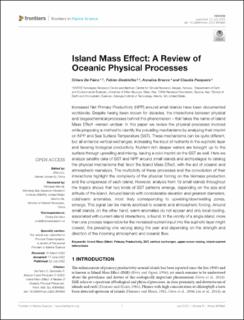| dc.contributor.author | De Falco, Chiara | |
| dc.contributor.author | Desbiolles, Fabien | |
| dc.contributor.author | Bracco, Annalisa | |
| dc.contributor.author | Pasquero, Claudia | |
| dc.date.accessioned | 2023-01-16T08:15:56Z | |
| dc.date.available | 2023-01-16T08:15:56Z | |
| dc.date.created | 2022-09-24T10:13:00Z | |
| dc.date.issued | 2022 | |
| dc.identifier.citation | Frontiers in Marine Science. 2022, 9 . | en_US |
| dc.identifier.issn | 2296-7745 | |
| dc.identifier.uri | https://hdl.handle.net/11250/3043563 | |
| dc.description.abstract | Increased Net Primary Productivity (NPP) around small islands have been documented worldwide. Despite having been known for decades, the interactions between physical and biogeochemical processes behind this phenomenon – that takes the name of Island Mass Effect –remain unclear. In this paper we review the physical processes involved while proposing a method to identify the prevailing mechanisms by analyzing their imprint on NPP and Sea Surface Temperature (SST). These mechanisms can be quite different, but all enhance vertical exchanges, increasing the input of nutrients in the euphotic layer and favoring biological productivity. Nutrient-rich deeper waters are brought up to the surface through upwelling and mixing, leaving a cold imprint on the SST as well. Here we analyze satellite data of SST and NPP around small islands and archipelagos to catalog the physical mechanisms that favor the Island Mass Effect, with the aid of oceanic and atmospheric reanalysis. The multiplicity of these processes and the convolution of their interactions highlight the complexity of the physical forcing on the biomass production and the uniqueness of each island. However, analysis from 19 small islands throughout the tropics shows that two kinds of SST patterns emerge, depending on the size and altitude of the island. Around islands with considerable elevation and greatest diameters, cold/warm anomalies, most likely corresponding to upwelling/downwelling zones, emerge. This signal can be mainly ascribed to oceanic and atmospheric forcing. Around small islands, on the other hand, warm anomalies do not appear and only local cooling, associated with current-island interactions, is found. In the vicinity of a single island, more than one process responsible for the increased nutrient input into the euphotic layer might coexist, the prevailing one varying along the year and depending on the strength and direction of the incoming atmospheric and oceanic flow. | en_US |
| dc.language.iso | eng | en_US |
| dc.rights | Navngivelse 4.0 Internasjonal | * |
| dc.rights.uri | http://creativecommons.org/licenses/by/4.0/deed.no | * |
| dc.title | Island Mass Effect: A Review of Oceanic Physical Processes | en_US |
| dc.title.alternative | Island Mass Effect: A Review of Oceanic Physical Processes | en_US |
| dc.type | Peer reviewed | en_US |
| dc.type | Journal article | en_US |
| dc.rights.holder | Copyright © 2022 De Falco, Desbiolles, Bracco and Pasquero | en_US |
| dc.description.version | publishedVersion | en_US |
| cristin.ispublished | true | |
| cristin.fulltext | original | |
| cristin.qualitycode | 1 | |
| dc.identifier.doi | 10.3389/fmars.2022.894860 | |
| dc.identifier.cristin | 2055021 | |
| dc.source.journal | Frontiers in Marine Science | en_US |
| dc.source.volume | 9 | en_US |
| dc.source.pagenumber | 21 | en_US |

